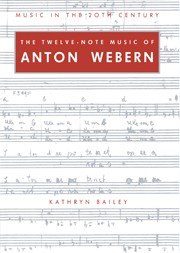Book contents
- Frontmatter
- Contents
- Acknowledgements
- Conventions in the text
- Introduction
- PART I Row and canon
- PART II The instrumental music
- Introduction to Part II
- 4 The movements in sonata form: Opp. 20/ii, 21/i, 22/i, 24/i and 27/i
- 5 The movements in variation form: Opp. 21/ii, 24/iii, 27/iii, 28/i and 30
- 6 The movements in rondo and ternary forms: Opp. 20/i, 22/ii, 24/ii, 28/ii and 28/iii
- 7 The movement in binary form: Op. 27/ii
- PART III The music with voices
- Conclusion
- Appendices
- Notes
- Glossary
- Chronological worklist
- Select bibliography
- Index
Introduction to Part II
Published online by Cambridge University Press: 23 December 2009
- Frontmatter
- Contents
- Acknowledgements
- Conventions in the text
- Introduction
- PART I Row and canon
- PART II The instrumental music
- Introduction to Part II
- 4 The movements in sonata form: Opp. 20/ii, 21/i, 22/i, 24/i and 27/i
- 5 The movements in variation form: Opp. 21/ii, 24/iii, 27/iii, 28/i and 30
- 6 The movements in rondo and ternary forms: Opp. 20/i, 22/ii, 24/ii, 28/ii and 28/iii
- 7 The movement in binary form: Op. 27/ii
- PART III The music with voices
- Conclusion
- Appendices
- Notes
- Glossary
- Chronological worklist
- Select bibliography
- Index
Summary
So let there be no mistake: we haven't departed from the forms of the classical composers. What has happened since is only alteration, extension, abbreviation… but the forms remain the same.
On the face of things it seems ironic that the forms chosen by Schoenberg and Webern – indisputably atonal composers – should have been those current in the classical era, of all periods of Western music the one in which major/minor tonality occupied the most commanding position; on more careful consideration, it was probably inevitable. The two composers were the product of a late nineteenth-century Austrian musical education, in which the three central disciplines of Harmonielehre, Kontrapunkt and Formenlehre were equal components. That a musician should not only study the traditional forms but demonstrate a facility in composing with them was understood. They represented the means through which musical expression was accomplished, and in well over a century they had not been seriously challenged: trouble definitely loomed on the horizon for tonal harmony, and strict counterpoint had fallen out of fashion much earlier, but the forms of Mozart, Haydn and Beethoven had simply been adjusted to serve succeeding generations of composers. And as the three disciplines were treated pedagogically as separate, it is possible that turbulent changes in one – as had already occurred in the case of counterpoint – might not be seen as threatening the others.
For both Schoenberg and Webern, the return to some sort of tonal discipline (in the form of the twelve-note technique) after some years of composing freely atonal music was seen as a welcome opportunity also to re-embrace the traditional homophonic forms that they felt to be so important. In some cases this return to the old forms is indicated through titles: suite, variations, concerto, symphony.
- Type
- Chapter
- Information
- The Twelve-Note Music of Anton WebernOld Forms in a New Language, pp. 147 - 152Publisher: Cambridge University PressPrint publication year: 1991

